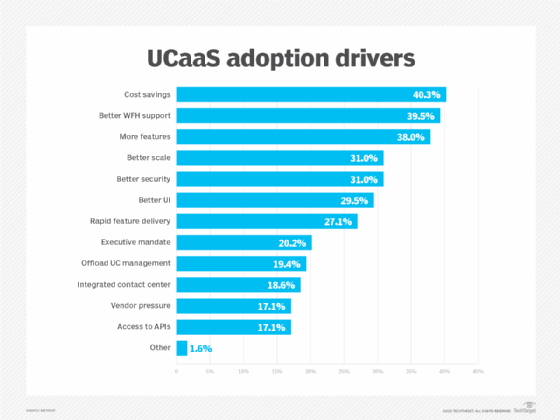Consolidate UCaaS platforms for the post-pandemic workplace
Enterprises preparing for the post-pandemic workplace are reevaluating their UCaaS platforms. Learn the benefits of a consolidated architecture and why it's not for everyone.
In early 2020, the COVID-19 pandemic forced many organizations to quickly shift to an entirely remote workforce. Most businesses weren't prepared for the sudden influx of remote workers and quickly deployed a variety of cloud-based unified communications tools to reduce the disruption to collaborative workflows.
While remote work will remain the norm for many employees, enterprises are now reevaluating their investments and buying priorities as they plan for the post-pandemic workplace. For many organizations, that will mean consolidating their unified communications as a service (UCaaS) setups and evaluating a single-vendor approach to communications.
The benefits of a single-vendor UCaaS platform include simplified UX, reduced costs, improved security and easier management, said Irwin Lazar, analyst at research firm Metrigy. Consolidation also becomes more attractive as vendors broaden their portfolios. Zoom, for example, now offers an enterprise-grade phone system so businesses that use Zoom for meetings can eliminate their separate voice platform, he said.
Broader UCaaS portfolios could spell end of standalone providers
The pandemic created new communications needs in remote workflows, particularly around meeting productivity features such as transcriptions, note taking and polling -- in many cases, leading to deployment of standalone apps that provide these features.
"Vendors now are seeing these opportunities to expand tools to meet their use cases to retain customers," Gartner analyst Christopher Trueman said. Some vendors are choosing to expand their portfolios through in-house development or acquisitions. Microsoft, for example, developed a webinar capability in Teams to address the need for companies to support larger events in their UCaaS platforms. Meanwhile, Cisco made a few acquisitions over the last year -- including Slido last December and Socio Labs in July -- to add support for hybrid events, webinars and audience interaction to its Webex platform. The challenge now for organizations would be to find a provider that meets all their communications requirements, Trueman added.
"The era of the standalone provider is kind of over now," Lazar said. Even in markets where specialized platforms often reigned, such as the video meetings market, most vendors don't exclusively offer meeting services. Similarly, voice providers have added team collaboration and video to their offerings. "It's gotten harder to say, 'I need a best-of-breed solution,'" Lazar noted.

Many organizations are also consolidating their UCaaS and contact center architectures. Most UCaaS vendors offer an integrated platform with a native contact center feature or a partnership with a contact center provider. "It's a single, unified offering that's pre-integrated," Trueman explained. "That kind of approach meets the majority of enterprise requirements."
Yet in some scenarios, a single UCaaS platform simply can't address every communication use case, making deployment of a standalone tool necessary.
Complementing consolidated UCaaS architecture
The typical architecture for single-vendor UCaaS includes the core components of messaging, voice and video. Organizations requiring additional or more advanced functionality will need to bring in a standalone offering.
"The majority of organizations I speak to are pursuing a single vendor for UC," Trueman reported. "The key areas where that breaks down and they bring in a best-of-breed is in meetings and conferencing tools."
The popularity of virtual whiteboards, for example, has grown exponentially in response to demand for improved ideation in remote meetings. Most UCaaS providers, including Microsoft, Cisco, Google and Zoom, offer a basic whiteboard functionality for meetings. This functionality, Trueman explained, replicates the experience of a physical whiteboard with additional features like sticky notes.
Standalone virtual whiteboards, such as Mural, Miro and Klaxoon, provide advanced visual collaboration capabilities, including polling, templates and the ability to embed files and integrate with a variety of UCaaS and productivity platforms. In market segments, such as virtual whiteboards, a large amount of differentiation exists between UCaaS platforms and standalone tools. But this difference could open the door for market consolidation, Trueman reasoned, as major UCaaS vendors acquire smaller standalone players to round out their portfolios.
Complex UCaaS architectures require multivendor approach
Smaller organizations can usually get away with a single-vendor UCaaS platform, but large enterprises often have additional complexity in their communications environment that requires services from multiple vendors.
"It's not easy for a UCaaS provider like Zoom or RingCentral to maintain connectivity in every market," Lazar said. Microsoft Teams customers, for example, may use an integrated multivendor strategy as they migrate to the Teams phone system. Companies requiring dedicated public switched telephone network (PSTN) connectivity need additional carrier support.
"Microsoft doesn't really want to play in that game for providing phone number management or international calling," Lazar said. Microsoft offers Direct Routing and Operator Connect, which enables enterprises to maintain their carrier contracts and add PSTN connectivity and other advanced telephony features to the Teams phone system. These connectivity options are managed through the Teams admin portal.
Other UCaaS providers, including Zoom, take a similar approach with bring your own carrier (BYOC), so organizations can maintain their telephony infrastructure, such as Session Initiation Protocol trunks, when migrating to a UCaaS platform. BYOC can support a single-vendor approach if a company decides to standardize on a specific platform. A BYOC option means companies don't need to maintain a telephony platform that's separate from their messaging and meetings platform, Trueman explained.
This approach is also beneficial for enterprises that operate in multiple countries, Lazar added, because it's less expensive to use a carrier that already operates in the country, such as NTT Communications in Japan and Orange Business Services in Europe. "It's something you'll see more of as the UCaaS market matures and moves into larger enterprises," he said. "It's difficult for larger companies with contracts with PSTN providers around the world to break those."






